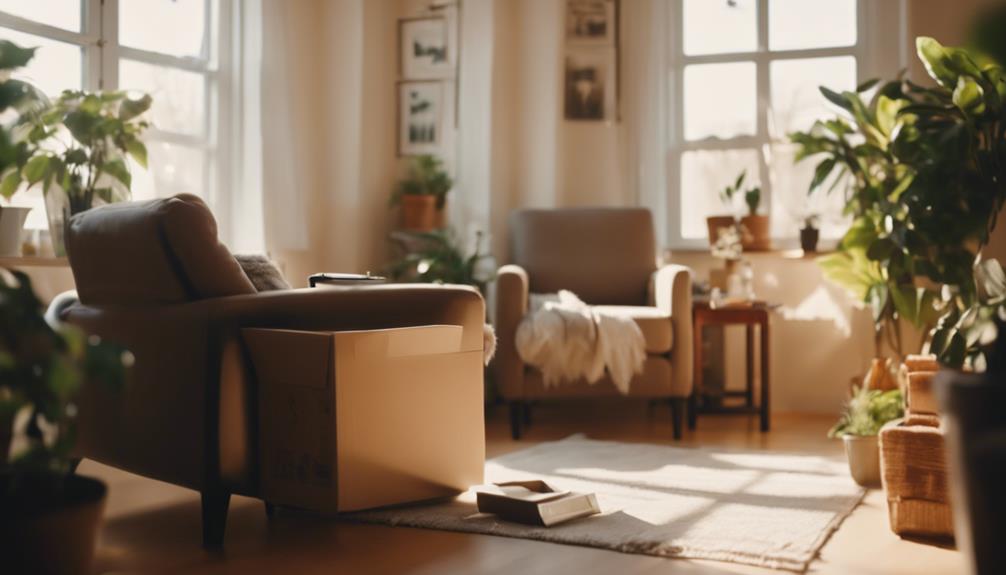To master your move, start with essential checklists that keep you organized. Begin by sorting and purging items, tackling low-sentiment rooms first. Create a purge pile for anything you haven't used in the last year. Clear your spaces by renting storage or packing donation boxes. Don't forget non-packing tasks like submitting change of address forms and notifying utility companies. Pack essentials and prepare for the first night in your new home. By using checklists, you'll reduce stress and stay on track. There's more to discover that can make your move smoother and more efficient.
Key Takeaways
- Create a detailed timeline for sorting, packing, and moving tasks to stay organized throughout the process.
- Utilize checklists for each room to ensure all items are accounted for and sorted effectively.
- Track essential non-packing tasks, such as address changes and utility notifications, to avoid last-minute stress.
- Prepare a packing checklist for essentials and VIP Box items to ensure you have everything needed for the first night.
Sort and Purge
Start by tackling a room with minimal sentimental value, like the kitchen or laundry, to make sorting easier.
Open closets, drawers, and boxes, and assess what you've got. Create a purge pile for items you haven't used in the last year—if it doesn't serve a purpose, it's time to let it go.
As you sort, pack non-essential and seasonal items progressively to keep things manageable. Remember, this isn't a race; allocate six to eight weeks for the entire sorting process.
Clear Your Spaces
To create a more organized environment, consider renting a storage space if you're downsizing or need extra room for your packed items. This can help you manage your belongings more effectively.
Next, focus on clearing your spaces by following these steps:
- Prepare donation boxes: Gather items you no longer need and drop them off or schedule pickups.
- List large items for sale: Use platforms like Craigslist to sell furniture or appliances you won't take with you.
- Dispose of unsellable items: Safely discard items that can't be donated or sold.
Lastly, designate an unused room as a temporary holding area for your packed boxes to keep everything organized as you prepare for your move.
Handle Non-Packing Tasks

Completing essential non-packing tasks ensures a smooth transition to your new home. You need to handle several important details before the big day. Start by filling out change of address forms at the post office, and let your children's schools know about record transfers. Contact utility companies to set start and stop dates for services. Additionally, consider scheduling cleaning or repair services for your old or new home.
| Task | Deadline | Notes |
|---|---|---|
| Change of address | 2 weeks prior | Online forms available |
| Notify schools | 3 weeks prior | Call admin office |
| Contact utility companies | 1 month prior | Check for service availability |
Taking care of these tasks early on will help you focus on packing later!
Pack Essentials and Say Goodbye
Packing essentials is crucial for a smooth transition to your new home, so gather important items like documents and an overnight bag early on. Focus on what you'll need right away once you arrive.
Here's a quick list to help you prepare:
- VIP Box: Include toiletries, paper products, and chargers for your devices.
- Bedding: Pack sheets and pillows for a restful first night in your new place.
- Overnight Bags: Prepare bags for kids and pets with their favorite toys and essentials.
Once you've packed these items, take a moment to say goodbye to your old space. Reflect on the memories, but look forward to the new adventures that await you!
Additional Tips for a Smooth Move

Staying organized with checklists can significantly reduce stress during your move.
Consider hiring professional movers; their expertise can save you time and effort. If you're worried about furniture logistics, explore rental services to help ease the transition.
Make sure you plan for your immediate needs at the new home—stock essential items and ensure everything is accessible. Aim to tackle moving tasks well in advance of the moving day to avoid last-minute chaos.
Communicate with friends or family helping you; a clear plan will keep everyone on the same page.
Conclusion
As you embark on your moving journey, remember that nearly 30% of people regret not decluttering before they move.
By using essential checklists to sort and purge your belongings, you can avoid this common pitfall and create a fresh start in your new space.
Embrace the process, tackle each task with confidence, and enjoy the clarity that comes from organizing your life.
With the right strategies, you'll turn chaos into order and make your move a breeze!










